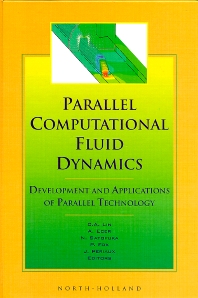North Holland
- 1st Edition
- July 28, 1999
- Y. Suzuki + 1 more
- English
- Paperback9 7 8 0 4 4 4 5 4 6 7 2 2
- Hardback9 7 8 0 4 4 4 5 0 2 8 9 6
- eBook9 7 8 0 0 8 0 5 4 8 7 6 0

Neutrino Physics and Astrophysics
- 1st Edition
- Volume 39
- June 17, 1999
- English
- eBook9 7 8 0 0 8 0 8 7 9 8 0 2

Progress in Optics
- 1st Edition
- Volume 28
- June 16, 1999
- Gerard Meurant
- English
- Paperback9 7 8 0 4 4 4 5 5 1 7 5 7
- Hardback9 7 8 0 4 4 4 5 0 1 6 9 1
- eBook9 7 8 0 0 8 0 5 2 9 5 1 6

Computer Solution of Large Linear Systems
- 1st Edition
- May 26, 1999
- Chiao-ling Lin + 4 more
- English
- Hardback9 7 8 0 4 4 4 8 2 8 5 0 7
- Paperback9 7 8 0 4 4 4 5 5 2 2 0 4
- eBook9 7 8 0 0 8 0 5 3 8 3 9 6

Parallel Computational Fluid Dynamics '98
- 1st Edition
- Volume 14
- May 4, 1999
- Cynthia Barnhart + 1 more
- English
- Hardback9 7 8 0 4 4 4 5 1 3 4 6 5
- Paperback9 7 8 1 4 9 3 3 0 2 2 9 1
- eBook9 7 8 0 0 8 0 4 6 7 4 3 6

Handbooks in Operations Research and Management Science: Transportation
- 1st Edition
- Volume 13
- April 7, 1999
- J.P. Marsh + 2 more
- English
- Paperback9 7 8 0 4 4 4 5 5 2 2 1 1
- Hardback9 7 8 0 4 4 4 8 2 8 7 4 3
- eBook9 7 8 0 0 8 0 5 5 2 1 3 2

Humane Interfaces
- 1st Edition
- Volume 10
- March 2, 1999
- D. Favrholdt
- English
- Paperback9 7 8 0 4 4 4 5 4 8 5 1 1
- Hardback9 7 8 0 4 4 4 8 9 9 7 2 9
- eBook9 7 8 0 0 8 0 8 7 1 0 8 0

Complementarity Beyond Physics (1928-1962)
- 1st Edition
- Volume 3
- February 11, 1999
- English
- Hardback9 7 8 0 4 4 4 8 1 8 0 1 0
- Paperback9 7 8 0 4 4 4 5 5 2 0 5 1
- eBook9 7 8 0 0 8 0 5 3 4 7 6 3

New Insulators Devices and Radiation Effects
- 1st Edition
- Volume 65
- December 16, 1998
- G. Zaccai + 2 more
- English
- Hardback9 7 8 0 4 4 4 5 0 0 8 6 1
- eBook9 7 8 0 0 8 0 9 2 9 1 2 5

From Cell to Brain
- 1st Edition
- Volume 1
- November 30, 1998
- English
- Paperback9 7 8 0 4 4 4 5 4 4 2 4 7
- eBook9 7 8 0 0 8 0 5 3 3 6 9 8

Recursive Model Theory